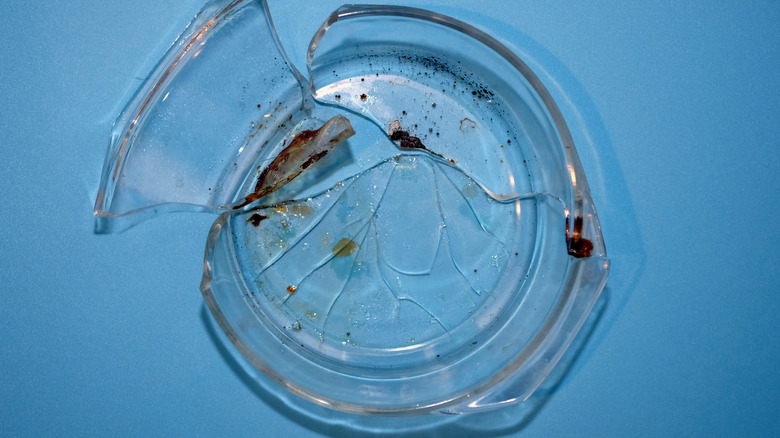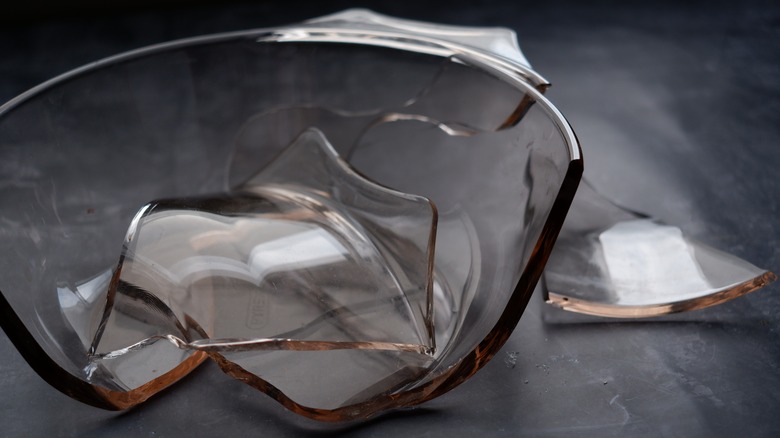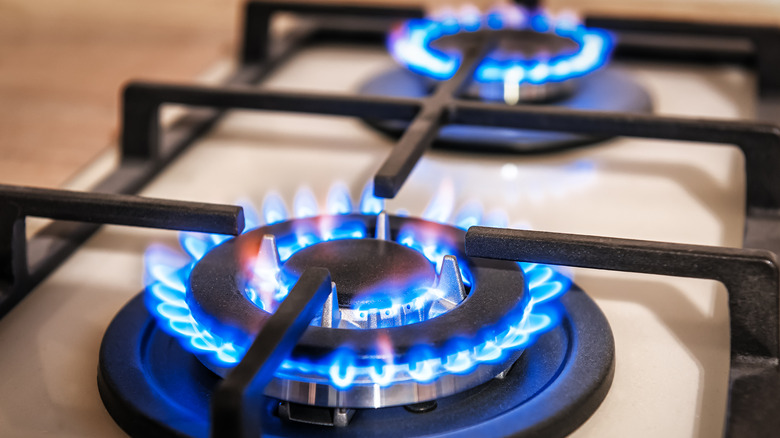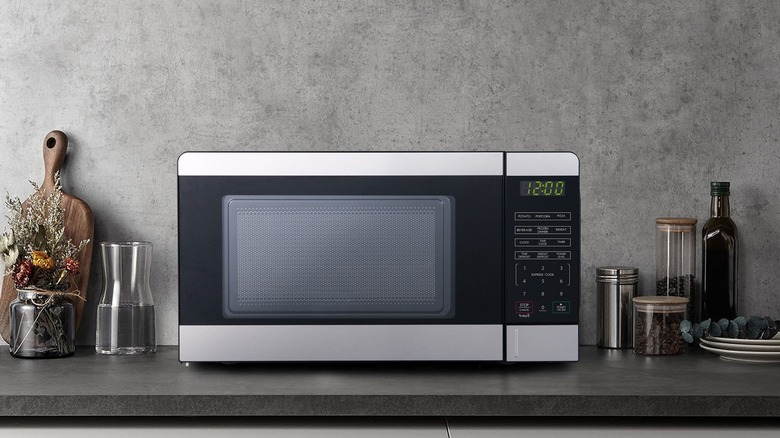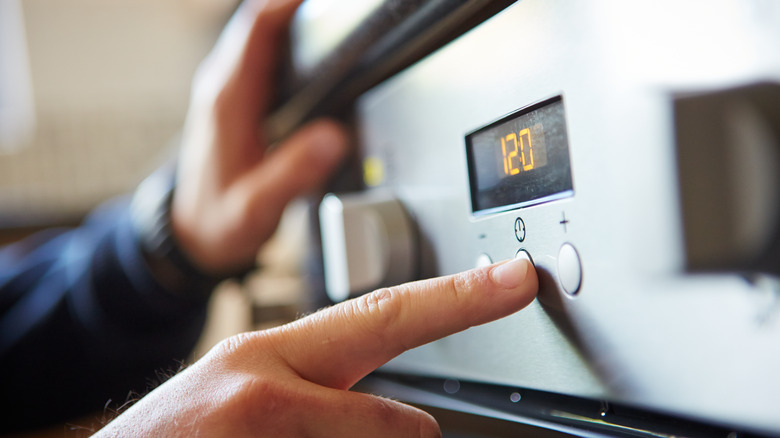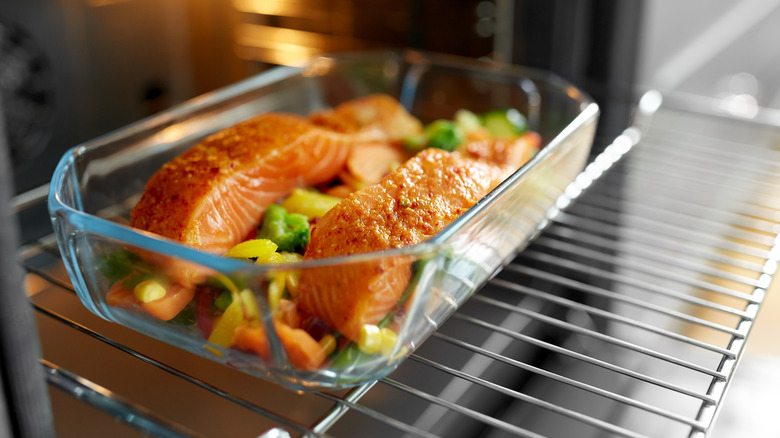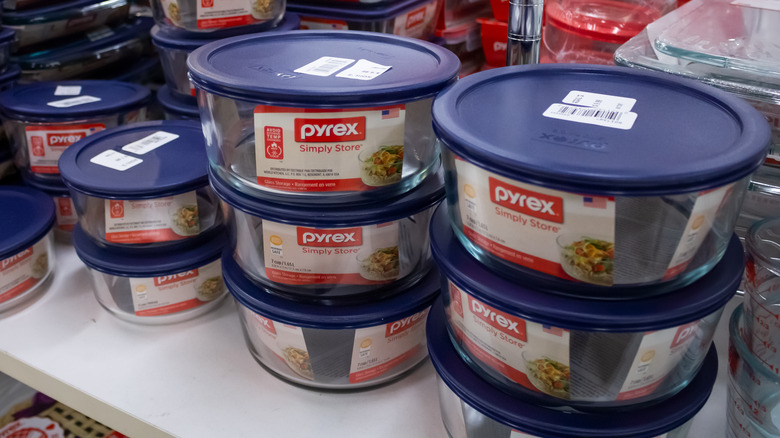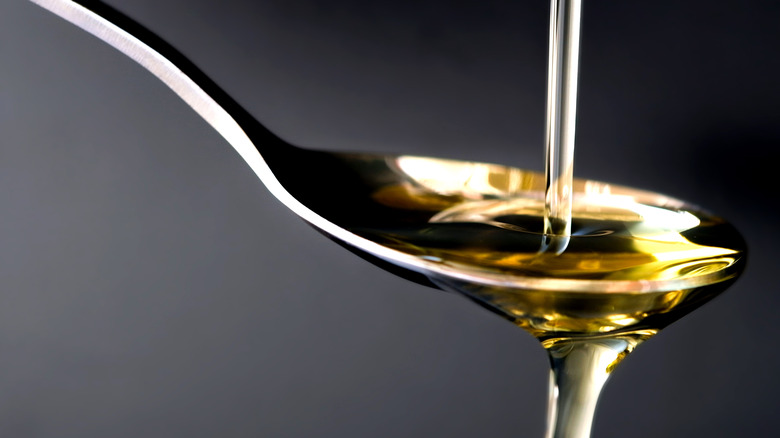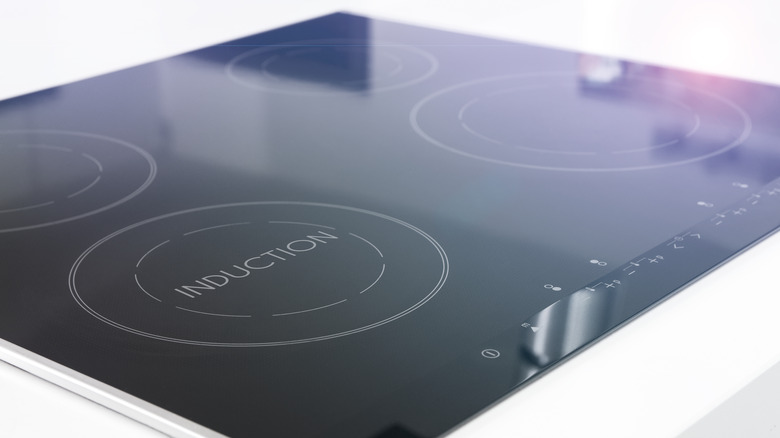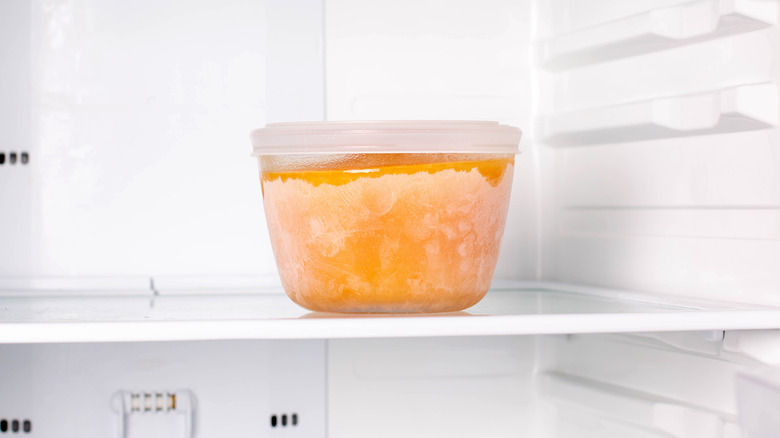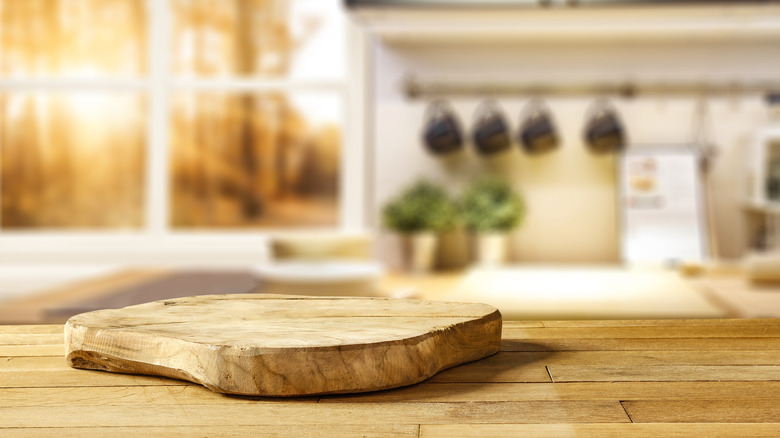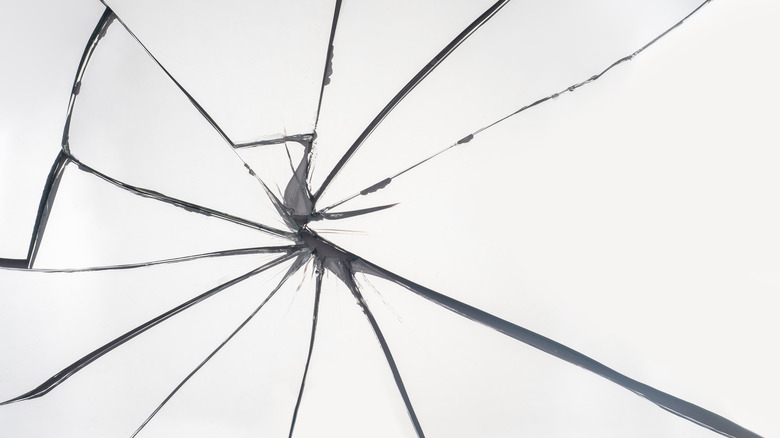12 Possible Reasons Your Glass Dish Exploded
For new home chefs, glass cookware is easily one of the most intimidating options around. It is more fragile than other types of cookware, which means it requires more care. Even Pyrex, a brand known for its durability, is prone to breakage. That's why vintage Pyrex is so in demand — because it was made using a stronger glass substance. Glassware is also sensitive to heat, can chip against surfaces, and crack quicker than you can blink an eye. Yet, despite the cons, many home chefs feel the pros are worth the extra bit of love and affection.
Glass cookware offers great visibility, making the attention-demanding job of cooking easier. Another clear benefit of glass is that it's non-toxic and non-porous. That means you can enjoy delicious meals worry-free, without undesirable flavors seeping into your food. If those qualities weren't enough to convert you into a devout glass cookware believer, just wait, there's more. From stovetop cooking to oven baking as well as fridge storage, it's one of the most versatile cookware options. With the right care, a great set of glass cookware will last you a lifetime — and look pretty doing it.
To keep your glassware crack-free and cooking, below is a list of some reasons why glass dishes explode. This might be a fear for some, but hopefully, this article encourages a glass-half-full-approach so that next time you're in the kitchen, you can dig that unused Pyrex baking pan from the back of your cabinet and put it to work.
Glass breaks under drastic temperature changes
Temperature has a funny way of warping and reshaping matter as it changes. Similar to stainless steel cookware, heat can impact glass dishes as well. Unlike their steely counterparts, glass cookware is less durable when exposed to massive temperature changes; it can easily crack, shatter, and pop. Their resilience depends on the quality of the construction. Nevertheless, we probably can all agree that a crack-free baking pan is better than a pile of shards.
That said, if past culinary pursuits have resulted in a glassy mess, drastic temperature change is probably a cooking mistake you didn't know you were making. Even Pyrex, whose steadfast reputation precedes itself, can fall victim to the tumultuous relationship between hot and cold. While most modern glass cookware is made of borosilicate or tempered glass, you'll still commonly find types made of soda-lime glass, which is less temperature resistant. Durability aside, each type is susceptible to cracking under drastic changes in temperature.
The best approach is to be mindful of when your hot glass cookware may come into contact with a cold surface, be it a wet kitchen towel or a chilly countertop. File this tip into your "Do Not Do" mental cabinet and you'll be enjoying more glass-cooked meals in no time.
Stovetops can damage glass cookware
A stovetop can both reward us with crave-worthy meals and leave us with disastrous results. It can serve as a pitstop for freshly cooked stir-fries before kids race into the kitchen for a plate. A hot stovetop can also quickly damage your favorite cookware. This is especially true of glass-made pots and pans. When cheffing with glass cookware, always avoid using the stovetop, unless the manufacturer label says it's safe. Doing so might cause it to explode.
Using the stovetop to let dishes cool down makes sense, as that's where hot dishes typically go. In reality, there's a reason you should never put a glass dish on the stove. If you want to reduce the chances of a shatter-fest, a cooling rack or dry dish towel are the recommended methods. As mentioned, many modern glass cookware options are labeled by the manufacturer as stovetop safe. While that may be true, they're made for even distribution of heat. Extended periods of focused heat will definitely cause the glass to break over time.
Frozen glass dishes aren't microwave-safe
In case you were wondering whether or not you should toss the glass container with frozen leftover meatballs in a microwave, the answer is a resounding "no." Under a microwave's nuking, glass cookware will experience thermal shock, a reaction that causes a rapid change in temperature. It's definitely one of the quickest ways to ruin any pan, and more specifically, make a shattered mess. In the kitchen, the only thing you want expanding is your belly full of food — and clearly, it wouldn't take kindly to meatballs with a side of savory shards.
Food and liquids change in size due to uneven heat distribution, which is when different areas of your cookware heat up at different speeds. That's why it's recommended to let frozen glass warm up to room temp before tossing it in the microwave. That said, for those with a macro-love for microwaves, look for glass cookware that is manufacturer approved. Whichever way you go, safe is always better than sorry, so make sure to keep an eye out while you zap your food.
The oven hasn't finished fully preheating
Preheating your oven is one of the most important, yet slept-on parts of cooking. We know, we know — if you happen to own one of those ovens that takes what seems like forever to warm up, you may scoff at the very idea. While we empathize, old ovens and smart ones alike require that extra bit of time to bring your tasty meal to life. Contrary to popular belief, when time isn't an available commodity, preheating actually saves you time. it can also save your glass cookware from breakage.
Sometimes we get impatient waiting for the oven to fully warm up, and decide to put our food in before it finishes. Preheating is such an important cooking step because many stoves start with high heat temperatures before settling at the designated heat. A surge of heat can be problematic for glass cookware, which doesn't respond well to drastic temperature changes. That's why it's important to wait until the oven has finished fully preheating before putting a glass baking pan inside. Thermal won't be the only shocking thing when you open your oven door to find fragments and food scattered below.
You didn't adjust the temperature of your oven
It's important to remember that even the most durable glass cookware can't withstand the heat levels that metal-based types can. For oven cooking, different approaches are definitely recommended. One tip you need when using glassware is to know when to adjust the temperature level. Unlike metal, glass acts as an insulator of heat rather than a conductor. That means that heat tends to pass through the glass, warming the contents instead.
As the food heats up, it transfers warmth to the glass, which then absorbs the heat, thereby insulating the food. That heat retention is why glass cookware can keep your food warmer for longer periods than metal cookware. That's also why you should lower the temperature by 25 degrees Fahrenheit since heat retention it contributes to the cooking process. Making that adjustment helps food to cook more evenly, and without making it, you can end up with an undercooked inside and browned outside. It may result in a longer cook time but is totally worth it. Along with making an overall better dish, you can reduce potential high heat damage.
Pyrex cookware will shatter under a broiler
We've come a long way since Pyrex helped launch the glass cookware market. Since then, it's gone from a super durable borosilicate material to shatter-prone soda lime glass. As much as we lament the reliable construction of yesteryear's Pyrex, it too stands no chance under the intense heat of a broiler. If you're one of those lucky home chefs that own vintage Pyrex cookware, you'll find that they can withstand temps up to 500 degrees Fahrenheit, but only 425 degrees Fahrenheit is recommended.
Well-constructed glassware can last a lifetime, especially the more durable vintage kinds. By comparison, new soda-lime glass Pyrex is considerably more susceptible to thermal shock, thus, the 550 degrees Fahrenheit that broilers emit will absolutely destroy your Pyrex dish or any glass cookware of your choosing. Whether vintage or modern, you should never put pyrex dishes in the broiler, always opt for metal. Metal will take the heat, while pyrex will ruin the eats. You'll thank us later when your bakeware doesn't crack under pressure.
Dry-cooking increases the chances of glass breaking
Another way to fortify your glass cookware is by adding some liquid. Oil makes the glass less susceptible to high heat by acting as a protective layer against cold juices that leak from uncooked food. Remember that glass is an insulator, which means that it requires contact from a hot surface in order to absorb heat. Until the food begins to cook and transfers its heat into the glass, the temperature is still fluctuating unevenly. Adding oil before food allows it to heat up first, thereby quickening the process. You should pour enough to fill the bottom of your dish.
Cooler juices from the food will leak as it cooks, dripping down onto the bottom of the glass baking pan. Heated oil captures the fallen juices, warming them as they touch the bottom while preventing the cooler temperature from directly contacting the glass. Basically, the hot oil safeguards the glass from drastic temperature changes. Try this quick oil trick next time you pull out the vintage Pyrex, or any glass cookware for that matter. Don't let the word "glass" fool you — these dishes are made for longevity, and with the right care, you'll be happily cooking in them for years to come.
You used glass cookware on a glass top stove
Commit this to memory: Stovetops are no place for glass cookware, and this is especially true for glass-top stoves. One surefire way to chip at the structural integrity of your cookware is through contact with other glass. Although glass cookware is durable, it's also easily scratchable, all it takes is a light tap to damage the surface. This is why setting one on a glass stovetop is a dangerous mistake you should never make.
From how you handle your glass pan to the way it's set atop the stove, each step is a potential mishap waiting to ruin your dish. Even stovetop-safe options should only be fired up on traditional gas pilots; just make sure to verify the manufacturer's label. In summary, always avoid contact between glass cookware and glass top stoves, unless you have a hankering for some glass fried rice. If you're cooking a longer recipe, toss it in an oven.
The glass dish expanded due to freezer exposure
Picture this: There are only 15 minutes left before you clock out, you're hungry as a hippo, and all you can think about is the leftover chicken and gravy in the freezer. You finally make it home after spending what feels like a lifetime in traffic. Anxiously hopping out of the car in a rush, you burst through the front door and into your kitchen. In brimming anticipation, you open your freezer only to find a shattered glass container.
Much like intense heat temperatures can cause glass to break, exposure to cold temps can as well. When foods or liquids are frozen, they expand, filling their container's empty space. That's why you shouldn't freeze food in glass, especially if you leave minimal room for expansion. Not only is it a potentially unsafe way to store food, but it'll also ruin your dinner plans and cause a mess. Fortunately, there are freezer-safe glassware options. What's great about them is their multi-purpose use; you can cook recipes in them and store the same glass container in the freezer for future meals. You won't have to worry about potential cracks as long as you let the glass cool to room temperature before storing it in cold freezers.
You placed a hot glass dish on a cold counter
Using glass cookware may seem like more of a hassle than it's worth, but the advantages are proven. Not only are they visually appealing, but they're also non-reactive to acidic foods, naturally non-stick, healthier for you, and can be used for cooking and storage. The extra bit of necessary care is a fair exchange for wide-ranging versatility. Speaking of care, you should never place a hot glass dish on a cold counter. Even a room temperature counter is kryptonite for these super versatile objects. Placing a protective layer between the hot glass and the kitchen counter is always suggested.
From sturdy kitchen towels to silicone trivet mats, along with a wide variety of pot holders, there are many options that work great for protecting your glass cookware from chilly surfaces. In any case, always make sure that they're dry, as wet kitchen towels will have a similar effect as cold countertops. Next time you're pulling a freshly cooked casserole from the oven, avoid the kitchen counter and cutting board and make sure it's set atop a dry and neutral surface. It'll better ensure a satisfying ending to your hour-long recipe.
Stacking glass cookware can cause fractures
After you've chosen a recipe, cooked it to perfection using your favorite vintage Pyrex, then shamelessly devoured it, there's no doubt the itis is casting a sleepy spell. Before you call it a night, it's time to put the dishes away. To make sure your glass cookware has a long and beautiful life, storing them properly is important. Unlike metal pots and pans, stacking glass on top of glass can not only lead to a messy cabinet but scratches and cracks as well. Basically, when you own and use glassware often, organization is key.
There are many tools and approaches to organizing glassware, which depend on your kitchen's layout. Those with extra counter space can use vertical or horizontal tray dividers for their glass baking pans, it makes it easier to quickly grab specific ones. Tray dividers also work well for organizing cabinets more efficiently. If you're on a budget or have limited cabinet space, it's perfectly okay to stack smaller glass dishes into larger ones. Just don't bang them around too much. Whether you're blessed with a dream kitchen or have mastered the confines of a tiny one, you should always be mindful of how you store glass cookware. A little bit of organizing goes a long way, and will certainly save you from having to clean up broken glass.
Glass dishes break when improperly packed
So you're preparing to move into a new home with a shiny new kitchen, and you're faced with the arduous task of carefully packing your fragile glassware; there's a right and wrong way to safely get the job done. Improperly packing glass is a one-way ticket to broken glass-ville. An annoying pot-hole here or an abrupt stop there, and say au revoir to your beloved glass cookware. To ensure safe arrival, there are a few recommended steps you should follow.
First thing first — find quality, sturdily-built small or medium-sized boxes. Larger ones are too spacious and won't provide the necessary support. Next, you'll need lots of newspaper or similar material that can be wrapped around each glass item as a protective layer. This helps prevent scratch damage from stacking cookware, ideally using at least two layers of sheets. Secure the newspaper with packing tape because you may need to remove ink stains after you finish unpacking.
Once each item is wrapped fully, fortify your boxes by adding extra tape to the bottoms. Glass cookware is sturdiest when placed on their side, so pack each vertically, being careful not to over-stuff the box. Leaving a bit of room at the top, further secure the items with any available linens, towels, or more balled-up pages of newspaper. The added protection, along with mindful handling, is the best bet for a safe and break-free move. That way, you'll continue the tradition of deliciously prepared glassware-cooked recipes.
